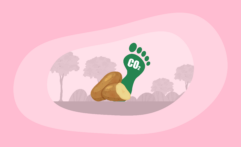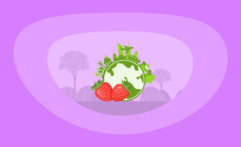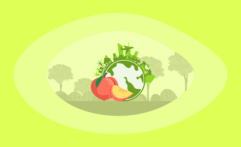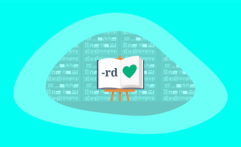What Is the Carbon Footprint of Cabbage? A Life-Cycle Analysis
Impactful Ninja is reader-supported. When you buy through links on our site, we may earn an affiliate commission.
Learn more
Learn more
.
Hey fellow impactful ninja ? You may have noticed that Impactful Ninja is all about providing helpful information to make a positive impact on the world and society. And that we love to link back to where we found all the information for each of our posts. Most of these links are informational-based for you to check out their primary sources with one click. But some of these links are so-called "affiliate links" to products that we recommend. First and foremost, because we believe that they add value to you. For example, when we wrote a post about the environmental impact of long showers, we came across an EPA recommendation to use WaterSense showerheads. So we linked to where you can find them. Or, for many of our posts, we also link to our favorite books on that topic so that you can get a much more holistic overview than one single blog post could provide. And when there is an affiliate program for these products, we sign up for it. For example, as Amazon Associates, we earn from qualifying purchases. First, and most importantly, we still only recommend products that we believe add value for you. When you buy something through one of our affiliate links, we may earn a small commission - but at no additional costs to you. And when you buy something through a link that is not an affiliate link, we won’t receive any commission but we’ll still be happy to have helped you. When we find products that we believe add value to you and the seller has an affiliate program, we sign up for it. When you buy something through one of our affiliate links, we may earn a small commission (at no extra costs to you). And at this point in time, all money is reinvested in sharing the most helpful content with you. This includes all operating costs for running this site and the content creation itself. You may have noticed by the way Impactful Ninja is operated that money is not the driving factor behind it. It is a passion project of mine and I love to share helpful information with you to make a positive impact on the world and society. However, it's a project in that I invest a lot of time and also quite some money. Eventually, my dream is to one day turn this passion project into my full-time job and provide even more helpful information. But that's still a long time to go. Stay impactful,Affiliate Disclosure
Why do we add these product links?
What do these affiliate links mean for you?
What do these affiliate links mean for us?
What does this mean for me personally?
![]()
Cabbage was once considered a luxury vegetable. It was served as an Ancient Roman preventative measure for hangovers and as a sailor’s method for fending off scurvy. With over 400 varieties, this brassica is popular in dishes all over the world: from fermented Korean kimchi and stuffed Polish golabki to English bubble and squeak. However, much less is shared about the environmental impact, and especially the carbon emissions of cabbage. So, we had to ask: What is the carbon footprint of cabbage?
Cabbage has a very low carbon footprint of 0.07 kg (0.19 lb) of CO2e per pound of produce. The main factors that contribute to these emissions are cabbage’s agricultural practices and packaging; the transporting footprint can be kept low by purchasing local produce.
In this article, we’ll walk you through the overall carbon emissions of the life-cycle of cabbage. From growing and packaging to transportation and end-of-life practices, you will learn how this vegetable affects the planet and discover some ways to reduce and offset the footprint.
Here’s How We Assessed the Carbon Footprint of Cabbage
The carbon footprint is one of the ways we measure the effects of our human-induced global climate change. It primarily focuses on the greenhouse gas (GHG) emissions associated with consumption, but also includes other emissions such as methane (CH4), nitrous oxide, and chlorofluorocarbons, and is generally expressed in carbon dioxide equivalents (CO2e).
“Carbon footprint: the amount of greenhouse gases and specifically carbon dioxide emitted by something (such as a person’s activities or a product’s manufacture and transport) during a given period”
Merriam Webster
Basically, it is the amount of carbon emitted by you as an individual or an organization providing you with goods and services – including cabbage:
- This includes GHG emissions from producing the products that we use and foods that we eat (e.g., power plants, factories or farms, and landfills)
- GHG emissions from fuel that we burn directly or indirectly (e.g., logistics and transportation, cooling or heating facilities),
- as well as the GHG emissions attributed to how we consume these products and foods.
To understand the carbon footprint of cabbage, we must assess its life-cycle and each stage’s sustainability. This life-cycle assessment (LCA) is a method to evaluate the environmental impacts of products and materials.
Here’s the Overall Carbon Footprint of Cabbage
The overall carbon footprint of cabbage is 0.07 kg (0.19 lb) of CO2e per pound of produce, which is very low in comparison to other foods. It has a similar carbon footprint to root vegetables, such as onions and potatoes, making it one of the least carbon-intensive vegetables. The main factors that cause these emissions are agriculture, transport, and packaging, with processing and end-of-life waste having a smaller impact.
Cabbage is a sustainable crop to grow and produce. It is a great choice of food if you are trying to reduce your carbon emissions.
| The carbon footprint of cabbage | 0.07 kg (0.19 lb) of CO2e per pound of cabbage |
So, let’s have a look at each stage of the LCA of cabbage!
| The life-cycle stages of cabbage | Each stage’s carbon footprint |
| Growing of cabbage | The carbon footprint of growing cabbage is 0.07 kg (0.15 lbs) of CO2e per pound of produce, which makes up a large 77.57% of the overall carbon footprint of cabbage. Cabbage is land-efficient, uses little water in comparison to other foods, and is treated with few pesticides. These factors all contribute to the low carbon footprint. |
| Harvesting, processing, and packaging of cabbage | The carbon footprint of harvesting, processing, and packaging cabbage is <0.07 kg (<0.15 lbs) of CO2e per pound of produce, which is 11% of the overall carbon footprint. Processed cabbages sold in plastic packaging have a higher carbon footprint than loose whole cabbages, due to the extra resources used. |
| Transporting of cabbage | The carbon footprint of transporting cabbage is <0.05 kg (<0.1 lbs) of CO2e per pound of produce, which amounts to 11.43% of the overall carbon footprint. Cabbage grows in many states, making it easy to buy locally-produced cabbage, which has a lower carbon footprint than imported crops. |
| End-of-life of cabbage | The carbon footprint of the end-of-life of cabbage is largely impacted by the amount of food and packaging wasted. Cabbage makes up 1.5% of all avoidable food waste, with 56,000 tons wasted a year. They are the 18th most wasted ingredient. Cabbages are often sold loose, but when packaged in plastic, they have a negative impact on the carbon footprint. |
These four stages can be broken down in more detail to understand the factors which impact the carbon footprint of cabbage.
What Is the Carbon Footprint of Growing Cabbage
The carbon footprint of growing cabbage is 0.07 kg (0.15 lbs) of CO2e per pound of produce, which makes up a large 77.57% of the overall carbon footprint of cabbage. Cabbage is land-efficient, uses little water in comparison to other foods, and is treated with few pesticides. These factors all contribute to the low carbon footprint.
The growing stage of most vegetables is carbon intensive, due to the land, pesticides, and water used to bring crops to maturity. However, in comparison to many other vegetables, cabbage uses relatively few of each one of these resources, making it a low-carbon food.
Which factors impact the carbon footprint of growing cabbage?
- How do cabbage grow: Cabbage is part of the brassica family and grows above ground. They can be grown outside in fields, in greenhouses, hydroponically, or even aeroponically. However, due to the heavy weight of cabbages, they are not often grown vertically. Cabbage grown outside also reduces the need for artificial light and heating systems, which produce carbon emissions.
- What is the growth duration of cabbage: Cabbage matures in about 20 weeks. This is a far longer growth duration than that of some salad leaves, which can be harvested in about 3-6 weeks. However, vegetables such as asparagus take a year to grow. Quick harvest times are beneficial to the environment because the land can be efficiently used to yield more produce.
- What is the land usage of cabbage: A good yield of cabbage would be between 30-70 tons per hectare of land usage. This makes it a land-efficient plant, like broccoli, thus not impacting the carbon footprint greatly.
- What is the water usage of cabbage: In order to produce a kilo of cabbage, 237 liters of water are needed. In comparison, beef requires 15,000 liters to produce just one kilo. The water footprint of cabbage is relatively low, so it does not have a large impact on the carbon footprint.
- What is the pesticide and fertilizer usage of cabbage: Cabbage ranked as the 10th “cleanest” crop, by the Environmental Working Group, meaning that the pesticide usage of this vegetable is very low in comparison to other crops. Pesticides produce carbon emissions through manufacturing, transportation, and application to crops. So, the fact that cabbage uses relatively low levels of pesticides is better for the carbon footprint.
In short, the growing process of cabbage releases comparatively low amounts of carbon emissions to many other vegetables. However, due to the resources used, it is the stage that is most carbon-intensive in the life-cycle of cabbage.
What Is the Carbon Footprint of Harvesting, Processing, and Packaging Cabbage
The carbon footprint of harvesting, processing, and packaging cabbage is <0.07 kg (<0.15 lbs) of CO2e per pound of produce, which is 11% of the overall carbon footprint. Processed cabbages sold in plastic packaging have a higher carbon footprint than loose whole cabbages, due to the extra resources used.
Hand harvesting is prevalent in the cabbage industry, due to easily damaged food. However, this produces fewer carbon emissions than crops harvested by machine, meaning that cabbage has a low carbon footprint.
Which factors impact the carbon footprint of harvesting, processing, and packaging cabbage?
- How are cabbage harvested: Most cabbages are harvested by hand. Some cabbages are harvested by machine, but this usually damages the crop, so is not used for fresh market cabbage. Hand-harvesting is labor-intensive but means that carbon-intensive machine harvesters are not used, making the overall carbon footprint low.
- How are cabbage processed: Cabbage is usually produced for the fresh market, meaning that the plant is sold unprocessed. So, few carbon emissions are released by processing. However, sometimes the vegetable is sold pre-chopped for consumer ease, which increases the carbon footprint of the crop.
- How are cabbage packaged: Cabbage is usually transported in mesh bags, fiberboard cartons, or wire crates. It is often sold loose, however, it is sometimes sold wrapped in plastic film. Opt for plastic-free cabbages, which have a lower carbon footprint than their pre-packaged counterparts.
In short, unprocessed cabbages sold loose have a lower carbon footprint than pre-cut varieties packaged in plastic. Due to the hand-harvesting of this crop, the carbon footprint of this stage in the life-cycle of cabbage is relatively low.
What Is the Carbon Footprint of Transporting of Cabbage
The carbon footprint of transporting cabbage is <0.05 kg (<0.1 lbs) of CO2e per pound of produce, which amounts to 11.43% of the overall carbon footprint. Cabbage grows in many states, making it easy to buy locally-produced cabbage, which has a lower carbon footprint than imported crops.
If cabbage is imported, the transportation time will be long and incredibly carbon-intensive. Reducing the need for methods of transport that are bad for the environment, like airfreights, drastically decreases the carbon footprint of this vegetable.
Which factors impact the carbon footprint of transporting cabbage?
- Where is cabbage grown: Cabbage is grown all across the US, but 78% of all US cabbage is grown in either California, Wisconsin, New York, Florida, or Texas. However, America imports 14.9% of the world imports of brassicas, largely from Mexico and Canada, which increases the carbon footprint. Opt for locally grown cabbage to reduce the carbon emissions of your purchase.
- How are cabbage transported: Cabbage is transported largely by truck, but can also be shipped by boat, rail, or air. Like most fresh produce, cabbage requires constant refrigeration during transportation. Cabbage should ideally be kept at a cool 32°F to prevent premature spoilage. Unfortunately, refrigerated vehicles can emit up to 29 times more potentially carcinogenic particulate matter and six times more nitrogen oxides than far larger, modern diesel truck engines. If cabbage is purchased from a local farm, the food miles, and thus the carbon footprint, is decreased.
In short, because cabbage can be grown all across the US, it is easier to find locally grown produce, which keeps the overall carbon footprint of this vegetable low.
What Is the Carbon Footprint of the End-of-Life of Cabbage
The carbon footprint of the end-of-life of cabbage is largely impacted by the amount of food and packaging wasted. Cabbage makes up 1.5% of all avoidable food waste, with 56,000 tons wasted a year. They are the 18th most wasted ingredient. Cabbages are often sold loose, but when packaged in plastic, they have a negative impact on the carbon footprint.
Cabbage has a shelf life of about two weeks, but only 2-3 days when cut, which could lead to waste. It is a compostable product, capable of creating sustainable fertilizer. However, it sadly often ends up rotting in a landfill. The packaging used can potentially be recycled, but can also end up in a landfill.
Which factors impact the carbon footprint of the end-of-life of cabbage?
- How are cabbage disposed of: Around 56,000 tonnes of avoidable cabbage waste is discarded every year. Cabbage is completely compostable but often ends up in landfills, which is a big problem for the environment. 16% of all food is wasted on farms, largely for aesthetic reasons. The resources used to grow these crops just to discard them are enormous and negatively impact the carbon footprint of cabbage.
- How is the packaging of cabbage disposed of: Cabbage is sometimes sold in plastic packaging to increase shelf life and prevent damage. Many of the polyethylene bags used for packaging are recyclable, as long as the polyethylene is not bonded with other plastics. This is because polyethylene is generally only recycled to make like-for-like products. However, a lot of plastic that we recycle ends up on the other side of the world, causing a threat to developing countries. So, it is much more sustainable to buy loose produce where possible.
In short, the relatively short shelf life of cabbage after being cut could lead to food waste. If waste is created, choose to compost or recycle it. However, purchasing loose cabbage is the simplest way to reduce carbon emissions due to plastic packaging.
How Does the Carbon Footprint of Cabbage Compare to Other Types of Food
Cabbage has a low carbon footprint compared with other foods. In comparison to other popular vegetables, it ranks alongside root vegetables like onions and potatoes. So, if you are looking for a low-carbon snack that is also super healthy, cabbage is a good choice.
Let’s see how cabbage ranks in comparison to other types of vegetables.
How Does the Carbon Footprint of Cabbage Compare to Other Types of Vegetables
In comparison to other vegetables, the carbon footprint of cabbage is very low. For example, cucumbers produce nearly fourteen times the carbon emissions of cabbage. Cabbage ranks as a vegetable with one of the lowest carbon footprints!
So, cabbage has a very low carbon footprint in comparison with other vegetables. But how does it compare to other types of food?
How Does the Carbon Footprint of Cabbage Compare to Other Types of Food in General
As a brassica, cabbage is one of the more sustainable options in comparison to other types of food. Brassicas, on average, produce around twelve times less greenhouse gas emissions than beef when compared calorically.
When it comes to greenhouse gas emissions (GHG), foods are often compared in terms of emissions per 1,000 kilocalories (as opposed to their weight in lbs or kg).
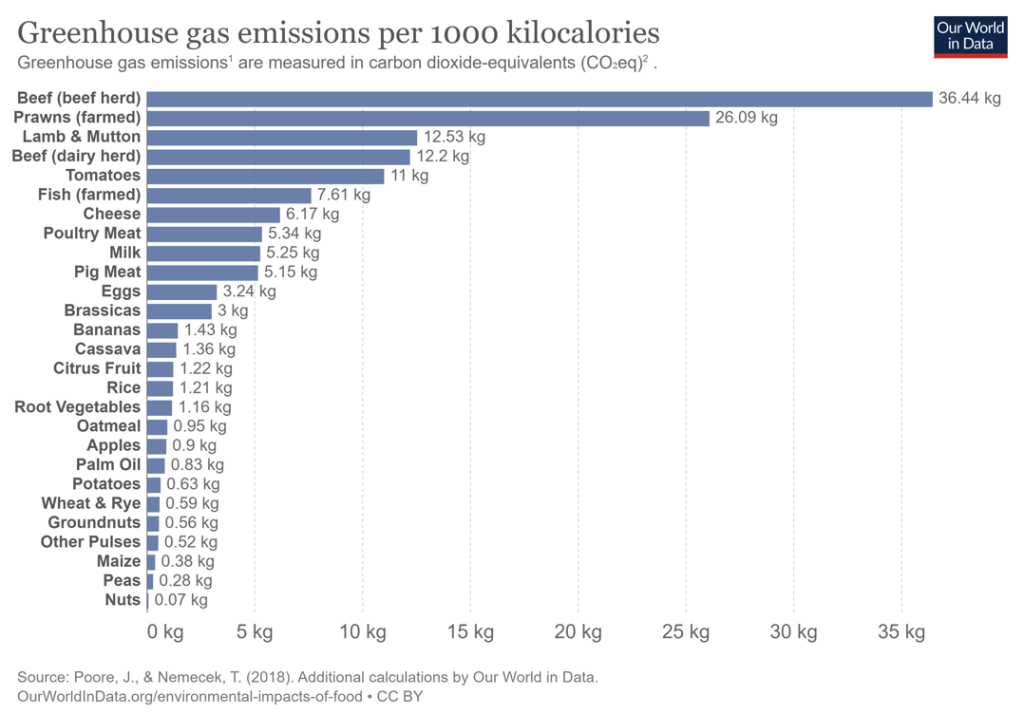
However, since cabbage is extremely low in calories, a far greater amount of produce is needed to equal 1,000 kilocalories.
- To eat 1,000 kilocalories, you would need to consume 43 servings, or around 153 ounces.
- In comparison to beef, you would only need 4.6 servings to eat 1,000 kilocalories, or 16 ounces.
- Comparatively, cabbage has a high carbon footprint per kilocalorie, but is enormously less calorific than animal-based food.
- More calorific plant-based foods, such as pulses and nuts, have a minuscule carbon footprint in comparison to animal-based proteins. A single portion of beef amounts to around 9.5 portions of cabbage, in terms of calories.
- This means that per portion, you will be consuming fewer calories, and so the carbon footprint will not be as large as this graph suggests.
Even though the carbon emissions for cabbage are low in comparison to other types of food, try to be mindful of the ways you can lessen your environmental impact when you purchase it.
How Can You Reduce and Offset Your Personal Carbon Footprint
All of the food you eat will have some form of carbon footprint, even when you buy foods with low CO2e, such as cabbage. However, there are ways to offset and reduce your personal carbon footprint.
There are a few easy techniques to buy more eco-friendly cabbage, and you can also find ways to offset the carbon footprint after your purchase.
How Can You Reduce Your Carbon Footprint When Shopping for Cabbage
When shopping for cabbage, consider these ways to lessen your impact on the environment.
- Shop locally and seasonally: Cabbage is a cool season crop, and is in peak season from late fall to early spring. Buying from local farms reduces the carbon emissions produced and makes it a much more sustainable choice.
- Choose organic: Organic cabbage produces a much lower carbon footprint than non-organic vegetables, due to the lack of pesticide production, distribution, and the overall higher health of soil for crops, insects, and animals.
- Avoid waste: Cabbage has a relatively short shelf life when cut, meaning it may end up going bad in the refrigerator. Avoid this by storing your cabbage correctly and consuming it quickly.
Taking these actions is a great way to lessen your own carbon footprint, but there are also ways to offset the impact of consuming cabbage as well.
How Can You Offset Your Personal Carbon Footprint
Carbon offsets are reductions in carbon emissions that are used to compensate for carbon emissions occurring elsewhere – for example for the carbon emissions that are associated with cabbage. They are measured in tons of CO2 equivalents and are bought and sold through international brokers, online retailers, and trading platforms on what is known as the global carbon offset market.
“Carbon Offset: a way for a company or person to reduce the level of carbon dioxide for which they are responsible by paying money to a company that works to reduce the total amount produced in the world, for example by planting trees”
Oxford Dictionary
In terms of cabbage – and indeed all food types – there will always be a carbon footprint, because of the resources it takes to get your food from farms to the place where you’ll eventually eat them. And while there are ways to reduce your carbon footprint when shopping for cabbage, carbon offsets would be a way to reduce your CO2e emissions all the way down to net zero (or even to become climate positive).
However, when you purchase carbon offsets, it’s important that they actually make a difference in offsetting (aka reducing) total carbon emissions. To achieve that, the following are key criteria:
- Carbon offset projects have to be effective (different projects have different effectiveness rates)
- Carbon offset projects have to be additional
- Carbon offset projects have to be permanent
- The claims from carbon offset projects have to be verifiable
To find the best carbon offsets for you personally, check out our full guide on the best carbon offsets for individuals, where you’ll also learn more about how these carbon offset projects work, what their respective offsetting costs are, and what your best way would be to offset your own carbon emissions.
Final Thoughts
Cabbage has a very low carbon footprint when compared with other vegetables, and an even lower carbon footprint when compared with other foods in general. However, you can try to reduce your carbon footprint even further by eating organic, reducing food and plastic waste, and purchasing local, seasonal produce. When you do enjoy cabbage, think about whether you can offset the carbon emissions created in order to make this healthy vegetable an even more sustainable option!
Stay impactful,

Sources
- Fresh City Farms: 9 Facts You Might Not Know About Cabbage
- Minimalist Baker: Easy Vegan Kimchi
- Lazy Cat Kitchen: Baked vegan cabbage rolls (gołąbki)
- A Virtual Vegan: Bubble and Squeak
- Britannica: Carbon footprint
- EPA: Vocabulary Catalog
- Science Direct: Life-cycle assessment (LCA)
- Carbon Cloud: Cabbage
- Impactful Ninja: What Is the Carbon Footprint of Onions
- Impactful Ninja: What Is the Carbon Footprint of Potatoes
- WRAP: The Food We Waste
- Hydrobuilder: How To Grow Hydroponic Cabbage
- Agrotonomy: Growing cabbages aeroponically on a Tower Garden
- Gardeners’ World: How to grow Cabbages
- Impactful Ninja: What Is the Carbon Footprint of Salad Mix
- WikiFarmer: How to grow Cabbage – Cabbage Complete Growing Guide from Seeding to Harvesting
- Impactful Ninja: What Is the Carbon Footprint of Broccoli
- The Guardian: How much water is needed to produce food and how much do we waste?
- Less Saves the Planet: All About Cauliflower
- Environmental Working Group: Full List
- University of Georgia: Commercial Production and Management of Cabbage and Leafy Greens
- NC State: Postharvest Cooling and Handling of Cabbage and Leafy Greens Postharvest Cooling and Handling of North Carolina Fresh Produce
- Farms Wise: Are Tractors Bad for the Environment?
- Agricultural Marketing Resource Centre: Cabbage
- Trend Economy: Cabbages, cauliflowers, kohlrabi, kale | Imports and Exports | 2021
- Professional Produce: Cabbage
- ACR Journal: Refrigerated vehicles contribute to thousands of deaths and costs across EU
- World Wildlife Fund: Fight climate change by preventing food waste
- World Wildlife Fund: What farmers found when they measured fresh produce left in the field
- Let’s Recycle: Supermarkets to take back plastic film in-store
- Sesotec: Recycling more packaging –potential for PE and PP
- Live Science: The Plastic We ‘Recycle’ Is Actually Horrible for the Environment
- Impactful Ninja: What Is the Carbon Footprint of Cucumber
- Impactful Ninja: What Is the Carbon Footprint of Tomatoes
- Impactful Ninja: What Is the Carbon Footprint of Bell Peppers
- Impactful Ninja: What Is the Carbon Footprint of Asparagus
- Impactful Ninja: What Is the Carbon Footprint of Cauliflower
- Impactful Ninja: What Is the Carbon Footprint of Celery
- Impactful Ninja: What Is the Carbon Footprint of Kale
- Impactful Ninja: What Is the Carbon Footprint of Lettuce
- Impactful Ninja: What Is the Carbon Footprint of Carrots
- Our World in Data: Greenhouse Gas Emissions per 1000 kilocalories
- Nutritionix: 100 G Cabbage
- Healthline: Beef 101: Nutrition Facts and Health Effects
- Farm Flavor: What’s in Season: Cabbage
- Columbia Climate School: Is Organic Food Really Better for the Environment?
- Cedar Circle: Cabbage Storage
- Impactful Ninja: 12 Best Carbon Offsets for Individuals
